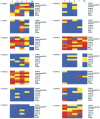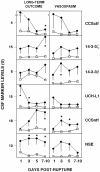Evidence that a panel of neurodegeneration biomarkers predicts vasospasm, infarction, and outcome in aneurysmal subarachnoid hemorrhage
- PMID: 22174930
- PMCID: PMC3235169
- DOI: 10.1371/journal.pone.0028938
Evidence that a panel of neurodegeneration biomarkers predicts vasospasm, infarction, and outcome in aneurysmal subarachnoid hemorrhage
Abstract
Biomarkers for neurodegeneration could be early prognostic measures of brain damage and dysfunction in aneurysmal subarachnoid hemorrhage (aSAH) with clinical and medical applications. Recently, we developed a new panel of neurodegeneration biomarkers, and report here on their relationships with pathophysiological complications and outcomes following severe aSAH. Fourteen patients provided serial cerebrospinal fluid samples for up to 10 days and were evaluated by ultrasonography, angiography, magnetic resonance imaging, and clinical examination. Functional outcomes were assessed at hospital discharge and 6-9 months thereafter. Eight biomarkers for acute brain damage were quantified: calpain-derived α-spectrin N- and C-terminal fragments (CCSntf and CCSctf), hypophosphorylated neurofilament H,14-3-3 β and ζ, ubiquitin C-terminal hydrolase L1, neuron-specific enolase, and S100β. All 8 biomarkers rose up to 100-fold in a subset of patients. Better than any single biomarker, a set of 6 correlated significantly with cerebral vasospasm, brain infarction, and poor outcome. Furthermore, CSF levels of 14-3-3β, CCSntf, and NSE were early predictors of subsequent moderate-to-severe vasospasm. These data provide evidence that a panel of neurodegeneration biomarkers may predict lasting brain dysfunction and the pathophysiological processes that lead to it following aSAH. The panel may be valuable as surrogate endpoints for controlled clinical evaluation of treatment interventions and for guiding aSAH patient care.
Conflict of interest statement
Figures



Similar articles
-
Alpha-II spectrin breakdown products in aneurysmal subarachnoid hemorrhage: a novel biomarker of proteolytic injury.J Neurosurg. 2007 Oct;107(4):792-6. doi: 10.3171/JNS-07/10/0792. J Neurosurg. 2007. PMID: 17937225
-
Identification and preliminary characterization of ubiquitin C terminal hydrolase 1 (UCHL1) as a biomarker of neuronal loss in aneurysmal subarachnoid hemorrhage.J Neurosci Res. 2010 May 15;88(7):1475-84. doi: 10.1002/jnr.22323. J Neurosci Res. 2010. PMID: 20077430
-
Serum and cerebrospinal fluid C-reactive protein levels as predictors of vasospasm in aneurysmal subarachnoid hemorrhage. Clinical article.Neurosurg Focus. 2009 May;26(5):E22. doi: 10.3171/2009.2.FOCUS08311. Neurosurg Focus. 2009. PMID: 19409001
-
Biomarker Discovery in Cerebral Vasospasm after Aneurysmal Subarachnoid Hemorrhage.J Stroke Cerebrovasc Dis. 2015 Jul;24(7):1453-64. doi: 10.1016/j.jstrokecerebrovasdis.2015.03.047. Epub 2015 May 6. J Stroke Cerebrovasc Dis. 2015. PMID: 25957908 Review.
-
Review of aneurysmal subarachnoid hemorrhage--focus on treatment, anesthesia, cerebral vasospasm prophylaxis, and therapy.Acta Anaesthesiol Taiwan. 2014 Jun;52(2):77-84. doi: 10.1016/j.aat.2014.04.005. Epub 2014 Jun 17. Acta Anaesthesiol Taiwan. 2014. PMID: 25016512 Review.
Cited by
-
Consensus summary statement of the International Multidisciplinary Consensus Conference on Multimodality Monitoring in Neurocritical Care: a statement for healthcare professionals from the Neurocritical Care Society and the European Society of Intensive Care Medicine.Neurocrit Care. 2014 Dec;21 Suppl 2(Suppl 2):S1-26. doi: 10.1007/s12028-014-0041-5. Neurocrit Care. 2014. PMID: 25208678 Free PMC article.
-
Reframing the Biological Basis of Neuroprotection Using Functional Genomics: Differentially Weighted, Time-Dependent Multifactor Pathogenesis of Human Ischemic Brain Damage.Front Neurol. 2018 Jun 26;9:497. doi: 10.3389/fneur.2018.00497. eCollection 2018. Front Neurol. 2018. PMID: 29997569 Free PMC article.
-
Advances in biomarkers for vasospasm - Towards a future blood-based diagnostic test.World Neurosurg X. 2024 Mar 3;22:100343. doi: 10.1016/j.wnsx.2024.100343. eCollection 2024 Apr. World Neurosurg X. 2024. PMID: 38487683 Free PMC article. Review.
-
Association between S100B Levels and Long-Term Outcome after Aneurysmal Subarachnoid Hemorrhage: Systematic Review and Pooled Analysis.PLoS One. 2016 Mar 23;11(3):e0151853. doi: 10.1371/journal.pone.0151853. eCollection 2016. PLoS One. 2016. PMID: 27007976 Free PMC article.
-
Evaluation of alpha-II-spectrin breakdown products as potential biomarkers for early recognition and severity of aneurysmal subarachnoid hemorrhage.Sci Rep. 2018 Sep 6;8(1):13308. doi: 10.1038/s41598-018-31631-y. Sci Rep. 2018. PMID: 30190542 Free PMC article. Clinical Trial.
References
-
- Bederson JB, Connolly ES, Jr, Batjer HH, Dacey RG, Dion JE, et al. American Heart Association (2009) Guidelines for the management of aneurysmal subarachnoid hemorrhage: a statement for healthcare professionals from a special writing group of the Stroke Council, American Heart Association. Stroke. 2011;40:994–1025. - PubMed
-
- Kassell NF, Sasaki T, Colohan AR, Nazar Cerebral vasospasm following aneurysmal subarachnoid hemorrhage. Stroke. 1985;16:562–572. - PubMed
-
- Kramer A, Fletcher J. Do endothelin receptor antagonists prevent delayed neurological deficits and poor outcomes after aneurysmal subarachnoid hemorrhage?: a meta-analysis. Stroke. 2009;40:3403–3406. - PubMed
-
- Vergouwen MDI, Vermeulen M, Gijn JV, Rinkel GJE, Wijdicks EF, et al. Definition of delayed cerebral ischemia after aneurysmal subarachnoid hemorrhage as an outcome event in clinical trials and observational studies. Stroke. 2010;41:2391–2395. - PubMed
Publication types
MeSH terms
Substances
Grants and funding
LinkOut - more resources
Full Text Sources

